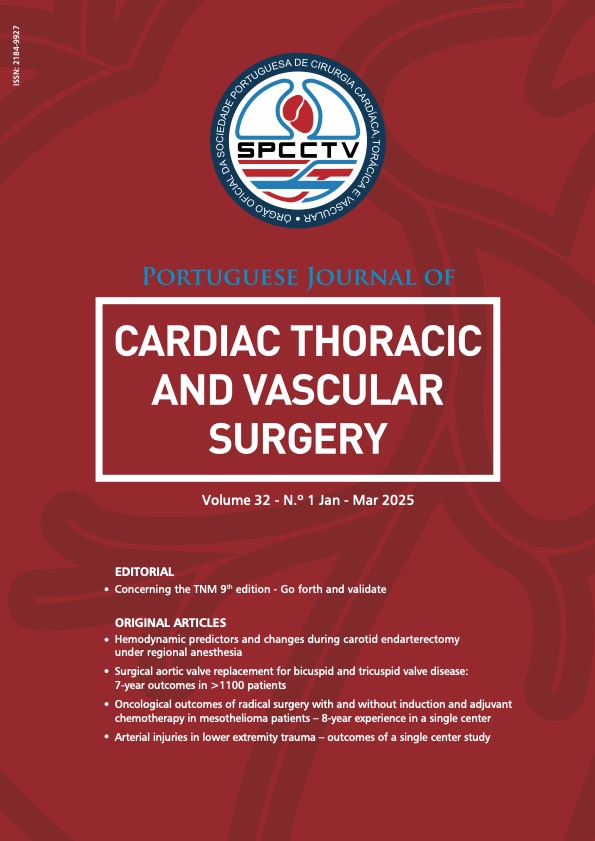Surgical Aortic Valve Replacement For Bicuspid And Tricuspid Valve Disease: 7-Year Outcomes In >1100 Patients
DOI:
https://doi.org/10.48729/pjctvs.531Keywords:
Surgical aortic valve replacement, congenital bicuspid aortic valve, tricuspid aortic valve, aortic valve surgery, aortic stenosis, aortic regurgitationAbstract
Introduction: Bicuspid aortic valve affects 0.5-2% of the population in developed countries. Given uncertainties about the best aortic valve replacement (AVR) option in this often younger, low-risk, population, it is important to understand how newer bioprostheses perform in these patients. The primary objective of this analysis was to compare 7-year outcomes of surgical AVR (SAVR) with the Avalus bioprosthesis between patients with a congenital bicuspid or tricuspid valve.Methods: This prospective, non-randomized study included 1132 patients with aortic valve stenosis or chronic severe aortic regurgitation who underwent successful SAVR with the Avalus bioprosthesis. Patients were categorized into bicuspid (n=339) and tricuspid (n=775) groups; 18 patients had unknown etiology. Kaplan-Meier analyses estimated valve-related adverse events over 7 years. Multivariable Cox proportional hazard models with propensity score adjustments evaluated the association of valve etiology with clinical outcomes, and a multivariable analysis identified risk factors for all-cause mortality.
Results: Patients with a tricuspid valve were older with more advanced heart failure symptoms and a higher mean Society of Thoracic Surgeons risk score (P<0.01). At 7 years postimplant, mortality was lower [8.9% (95% CI: 5.9%-13.4%) versus 21.3% (95% CI: 18.1%-24.9%), P<0.01] and non-structural valve dysfunction was higher in the bicuspid cohort [2.9% (95% CI: 1.5%-5.5%) versus 0.6% (95% CI: 0.2%-1.6%), P<0.01]. Other safety parameters were not significantly different. In the bicuspid and tricuspid cohorts, the respective mean effective orifice area was 2.0±0.5 and 2.0±0.5 at 7 years, and the respective mean aortic gradient was 13.6±6.4 and 14.1±5.7. Reintervention rates were low [6.8% (95% CI: 4.1%-10.9%) versus 5.4% (95% CI: 3.7%-7.8%), P=0.54] in both cohorts.
Conclusions: SAVR with the Avalus bioprosthesis yielded excellent 7-year outcomes for patients with either a congenital bicuspid or tricuspid valve. Hemodynamic performance and reintervention rates were similar between cohorts with low rates of other valve-related adverse events.
Downloads
References
Losenno KL, Goodman RL, Chu MWA. Bicuspid Aortic valve disease and ascending aortic aneurysms: gaps in knowledge. Cardiol Res Pr. 2012;2012(1):1452020. doi:10.1155/2012/145202.
Mehta CK, Liu TX, Bonnell L, Habib RH, Kaneko T, et al. Age-stratified surgical aortic valve replacement for aortic stenosis. Ann Thorac Surg. 2024;118(2):430-438. doi: 10.1016/j.athoracsur.2024.01.013.
Lamas CC, Eylyn SJ. Bicuspid aortic valve-a silent danger: analysis of 50 cases of infective endocarditis. Clin Infect Dis. 2000;30(2):336-341. doi: 10.1086/313646.
Ward C. Clinical significance of the bicuspid aortic valve. Heart. 2000;83(1):81-85. doi: 10.1136/heart.83.1.81.
Zghouzi M, Osman H, Ullah W, Suleiman AR, Razvi P, et al. Safety and efficacy of transcatheter aortic valve implantation in stenotic bicuspid aortic valve compared to tricuspid aortic valve: a systematic review and meta-analysis. Expert Rev Cardiovasc Ther. 2022;20(7):581-588. doi: 10.1080/14779072.2022.2094368.
Vahanian A, Beyersdorf F, Praz F, Milojevic M, Balbus S, et al. ESC/EACTS Scientific Document Group. 2021 ESC/EACTS Guidelines for the management of valvular heart disease. Eur Heart J. 2022;43(7):561-632. doi: 10.1093/eurheartj/ehab395. Erratum in: Eur Heart J. 2022;43(21):2022. doi: 10.1093/eurheartj/ehac051.
Jørgensen TH, Thyregod HGH, Savontaus M, Willemen Y, Blele Ø, et al. Transcatheter aortic valve implantation in low-risk tricuspid or bicuspid aortic stenosis: the NOTION-2 trial. Eur Heart J. 2024;45(37):3804-3814. doi: 10.1093/eurheartj/ehae331.
Mehaffey JH, Jagadeesan V, Kawara M, Hayange JW, Chauhan D, et al. Transcatheter versus surgical aortic valve replacement in bicuspid aortic valves. Ann Thorac Surg. 2024 Dec 10. doi: 10.1016/j.athoracsur.2024.11.023.
Otto CM, Nishimura RA, Bonow RO, Carabello BA, Erwin JP 3rd, et al. 2020 ACC/AHA Guideline for the management of patients with valvular heart disease: executive summary: a report of the American College of Cardiology/American Heart Association Joint Committee on Clinical Practice Guidelines. Circulation. 2021;143(5):e35-e71. doi: 10.1161/GR.00000000000932.
Sabik JF III, Rao V, Dagenais F, Moront MG, Reardon MJ, et al. Seven-year outcomes after surgical aortic valve replacement with a stented bovine pericardial bioprosthesis in over 1100 patients: a prospective multicentre analysis. Eur J Cardiothorac Surg. 2024;67(1). doi: 10.1093/ejcts/ezae414.
Sabik JF III, Rao V, Lange R, Kappetein AP, Dagenais F, et al. One-year outcomes associated with a novel stented bovine pericardial aortic bioprosthesis. J Thorac Cardiovasc Surg. 2018;156(4):1368-1377.e5. doi: 10.1016/j.jtos.2018.03.171.
Siu SC, Silversides CK. Bicuspid aortic valve disease. J Am Coll Cardiol. 2010;55(25):2789-2800. doi: 10.1016/j.jacc.2009.12.068.
Forrest JK, Kaple RK, Ramlawi B, Gleason TG, Meduri CU, et al. Transcatheter aortic valve replacement in bicuspid versus tricuspid aortic valves from the STS/ACC TVT registry. JACC Cardiovasc Interv. 2020;13(15):1749-1759. doi: 10.1016/j.jcin.2020.03.022.
Forrest JK, Ramlawi B, Deeb GM, Zahr F, Song HK, et al. Transcatheter aortic valve replacement in low-risk patients with bicuspid aortic valve stenosis. JAMA Cardiol. 2021;6(1):50-57. doi: 10.1001/jamacardio.2020.4738.
Makkar RR, Yoon SH, Leon MB, Chakravarty T, Rinaldi M, et al. Association between transcatheter aortic valve replacement for bicuspid vs tricuspid aortic stenosis and mortality or stroke. JAMA. 2019;321(22):2193-2202. doi: 10.1001/jama.2019.7108.
Deeb GM, Reardon MJ, Ramlawi B, Yakubov SJ, Chetcuti SJ, et al. Propensity-matched 1-year outcomes following transcatheter aortic valve replacement in low-risk bicuspid and tricuspid patients. JACC Cardiovasc Interv. 2022;15(5):511-522. doi: 10.1016/j.jcin.2021.10.027.
Williams MR, Jilalhawi H, Makkar R, O'Neill WW, Guyton R, et al. The PARTNER 3 bicuspid registry for transcatheter aortic valve replacement in low-surgical-risk patients. JACC Cardiovasc Interv. 2022;15(5):523-532. doi: 10.1016/j.jcin.2022.01.279.
Tchéché D, Zivello F, De Biase C, De Backer O, Hovasse T, et al. Transcatheter aortic valve implantation with the Evolut platform for bicuspid aortic valve stenosis: the international, multicentre, prospective BIVOLUTX registry. Eurointervention. 2023;19(6):502-511. doi: 10.4244/EIJ-D-23-00021.
Miyasaka M, Yoon SH, Sharma RP, Maeno Y, Jaideep S, et al. Clinical outcomes of transcatheter aortic valve implantation in patients with extremely large annulus and SAPIEN 3 dimensions based on post-procedural computed tomography. Circ J. 2019;83(3):672-680. doi: 10.1253/circj.CJ-18-1059.
Zaid S, Hirji SA, Bapat VM, Dentl P, Modine T, et al. Surgical explanation of failed transcatheter aortic valve replacement. Ann Thorac Surg. 2023;116(5):933-942. doi: 10.1016/j.athoracsur.2023.05.036.
Jawitz OK, Gulack BC, Grau-Sepulveda MV, Matsouaka RA, Mack MJ, et al. Reoperation after transcatheter aortic valve replacement: an analysis of the Society of Thoracic Surgeons database. JACC Cardiovasc Interv. 2020;13(13):1515–1525. doi: 10.1016/j.jcin.2020.04.029.
Bavaria JE, Mumtaz MA, Griffith B, Svensson LG, Pharot P, et al. Five-year outcomes after bicuspid aortic valve replacement with a novel tissue bioprosthesis. Ann Thorac Surg. 2024;118(1):173-179. doi:10.1016/j.athoracsur.2023.11.036.
Herrmann H, Pharot P, Wu C, Hahn R, Gilbert HL, et al. Bioprosthetic aortic valve hemodynamics: definitions, outcomes, and evidence gaps: JACC state-of-the-art review. J Am Coll Cardiol. 2022; 80(5):527–544. doi: 10.1016/j.jacc.2022.06.001.
Downloads
Published
How to Cite
License
Copyright (c) 2025 Portuguese Journal of Cardiac Thoracic and Vascular Surgery

This work is licensed under a Creative Commons Attribution 4.0 International License.





